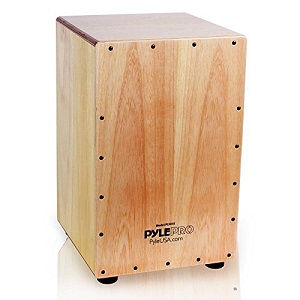Cajon
 The Cajon is a wooden box allows for several striking zones. Playing close to the edge of the box produces a higher pitched sharper tone which is perfect for use as a back beat similar to a snare drum in a traditional drum kit. As you move closer to the centre of the front the tone lowers in pitch and introduces a woody thump allowing the player to use it more like a Bass drum or Toms.
The Cajon is a wooden box allows for several striking zones. Playing close to the edge of the box produces a higher pitched sharper tone which is perfect for use as a back beat similar to a snare drum in a traditional drum kit. As you move closer to the centre of the front the tone lowers in pitch and introduces a woody thump allowing the player to use it more like a Bass drum or Toms.
Different scrape, pluck and muted or open hits create a range of interesting sounds. You can vary the pitch of the note depending on which part of the hand is used and by applying pressure to bend the wood with one hand or foot and hitting the head with the other.
Over the years the original box design of the Peruvian Cajon underwent many changes. A thinner sheet of wood added to the striking side gave hits a snap and a sound hole usually found in the back of the box provided better acoustic projection. Perhaps the most recognisable advancement in Cajon technology came about when renowned Afro-Peruvian percussionist Caitro Soto met with Spanish Flamenco guitarist Paco de Lucia who was immediately enamoured with the instrument. Caitro gave his Cajon to Paco who brought it back to Spain and added a set of guitar strings against the rear of the playing surface giving the Cajon a snare-like rattle when slapped which helped the backbeat of the rhythm to cut through other instruments. The resulting Flamenco Cajon developed into the snare Cajon which is now the most popular and widely used variation of the Cajon worldwide.